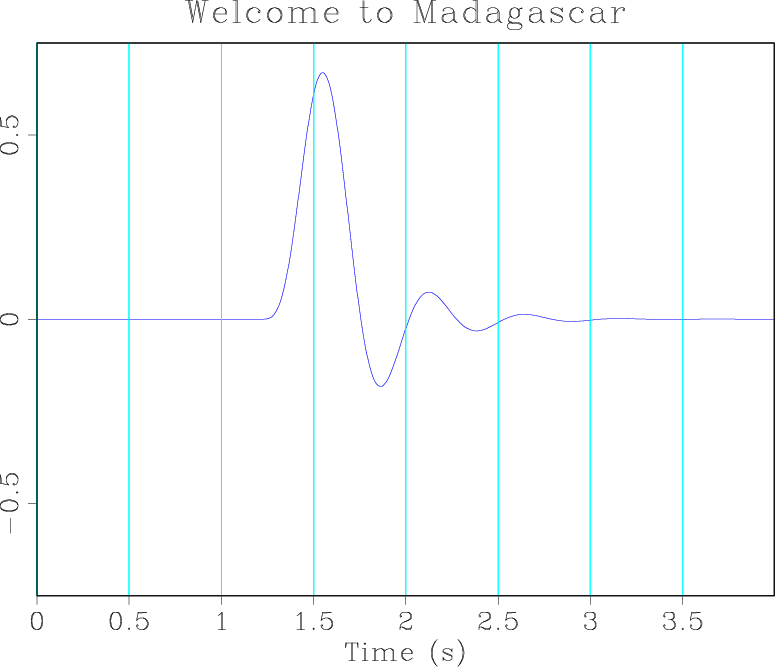Installation
Madagascar has been installed and is periodically tested on
- Different Linux distributions (Fedora, RedHat, SuSE, Debian, Ubuntu, Oracle, Mandriva)
- FreeBSD
- Solaris
- HP-UX
- SGI Irix
- MacOS X
- Windows under the Cygwin environment and under Microsoft's Services for UNIX environment.
Precompiled binary packages
A precompiled binary package of the latest Madagascar stable release exists for Mac OS X. See the Madagascar download page for details.
Installation from source
Prerequisites
- C compiler. ANSI-compliant compiler such as GCC should work. GCC usually comes pre-installed on Linux machines.
- Python interpreter. Python is an interpretable programming language. It is used in Madagascar installation scripts and project management scripts. Python comes pre-installed on some platforms.
Each API option has its own prerequisites.
Note that building under cygwin on Windows requires several preparatory steps.
Environmental variables
- Set the RSFROOT environmental variable to the directory where you want to install Madagascar.
- Set the PYTHONPATH environmental variable to include $RSFROOT/lib.
- Add $RSFROOT/bin to your PATH environmental variable
- Set DATAPATH to the directory for temporary data files.
Example configuration for csh and tcsh:
setenv RSFROOT /usr/local/rsf
if ($?PYTHONPATH) then
setenv PYTHONPATH ${PYTHONPATH}:$RSFROOT/lib
else
setenv PYTHONPATH $RSFROOT/lib
endif
set path = ($path $RSFROOT/bin)
setenv DATAPATH /var/tmp/
Example configuration for bash:
export RSFROOT=/usr/local/rsf
if [ -n "$PYTHONPATH" ]; then
export PYTHONPATH=${PYTHONPATH}:$RSFROOT/lib
else
export PYTHONPATH=$RSFROOT/lib
fi
export PATH=$PATH:$RSFROOT/bin
export DATAPATH=/var/tmp/
Notice the slash at the end of the DATAPATH variable.
Software construction
- Configuration. Change to the top source directory and run
./configure
You can examine the config.py file that this command generates. Additional options are available. You can obtain a full list of customizable variables by running scons -h. For example, to install C++ and Fortran-90 API bindings in addition to the basic package, run./configure API=c++,fortran-90
- Building and installing the package. Run scons install or the following two commands in succession:
make; make install
orscons; scons install
If you need "root" privileges for installing under $RSFROOT, you may need to runsu; scons install
orsudo scons install
- Cleaning. To clean all intermediate files generated by SCons, run
make clean
orscons -c
To clean all intermediate files and all installed files, runmake distclean
orscons -c install
Troubleshooting
Note that scons does not inherit your environmental variables including PATH. If the configuration part ends with the message like
checking if cc works ... failed
the problem may be that your compiler is in unusual place. Try
./configure CC=/full/path/to/cc
or
./configure CC=`which cc`
On Windows under SFU, use the gcc compiler
./configure CC=/opt/gcc.3.3/bin/gcc
For more information, please consult the Advanced Installation guide.
Testing and quick start
Here are a few simple tests and and a brief introduction to Madagascar:
Typing any Madagascar command in a terminal window without parameters should generate a brief documentation on that command. Try one of the following:
sfin sfattr sfspike sfbandpass sfwiggle
If you get an error like "Command not found", you may not have your $PATH environment variable set correctly, or you may need to issue the rehash command.
Now try making a simple Madagascar data file:
sfspike n1=1000 k1=300 > spike.rsf
This command generates a one dimensional list of 1000 numbers, all zero except for a spike equal to one at position 300. If this generates an error like
Cannot write to data file /path/spike.rsf@: Bad file descriptor
you may need to create the directory pointed to by your $DATAPATH environment variable.
The file spike.rsf is a text header. The actual data are stored in the binary file pointed to by the in= parameter in the header. You can look at the header file directly with more, or better, examine the file properties with
sfin spike.rsf
You can learn more about the contents of spike.rsf with
sfattr < spike.rsf
The following command applies a bandpass filter to spike.rsf and puts the result in filter.rsf:
sfbandpass fhi=2 phase=1 < spike.rsf > filter.rsf
The following command makes a graphics file from filter.rsf:
sfwiggle clip=0.02 title="Welcome to Madagascar" < filter.rsf > filter.vpl
If you have an X11 display program running, and your $DISPLAY environment variable is set correctly, you can display the graphics file with:
xtpen < filter.vpl
You can pipe Madagascar commands together and do the whole thing at once like this:
sfspike n1=1000 k1=300 | sfbandpass fhi=2 phase=1 | \ sfwiggle clip=0.02 title="Welcome to Madagascar" | xtpen
If you have SCons installed, you can use it to automate Madagascar processing. Here is a simple SConstruct file to make filter.rsf and filter.vpl:
<python>
- Setting up
from rsfproj import *
- Make filter.rsf
Flow('filter',None,
'spike n1=1000 k1=300 | bandpass fhi=2 phase=1')
- Make filter.vpl
Result('filter',
'wiggle clip=0.02 title="Welcome to Madagascar"')
End() </python>
Put the file in an empty directory, give it the name SConstruct, cd to that directory, and issue the command:
scons
The graphics file is now stored in the Fig subdirectory. You can view it manually with:
xtpen Fig/filter.vpl
... or you can use:
scons view
When an SConstruct file makes more than one graphics file, the scons view command will display all of them in sequence.

Now edit the SConstruct file: change the title string on the Result line to "Hello World!", save the file, and rerun the scons command. You will see that scons has figured out that the file filter.rsf does not need to be rebuilt because nothing that affects it has changed. Only the file filter.vpl is rebuilt.